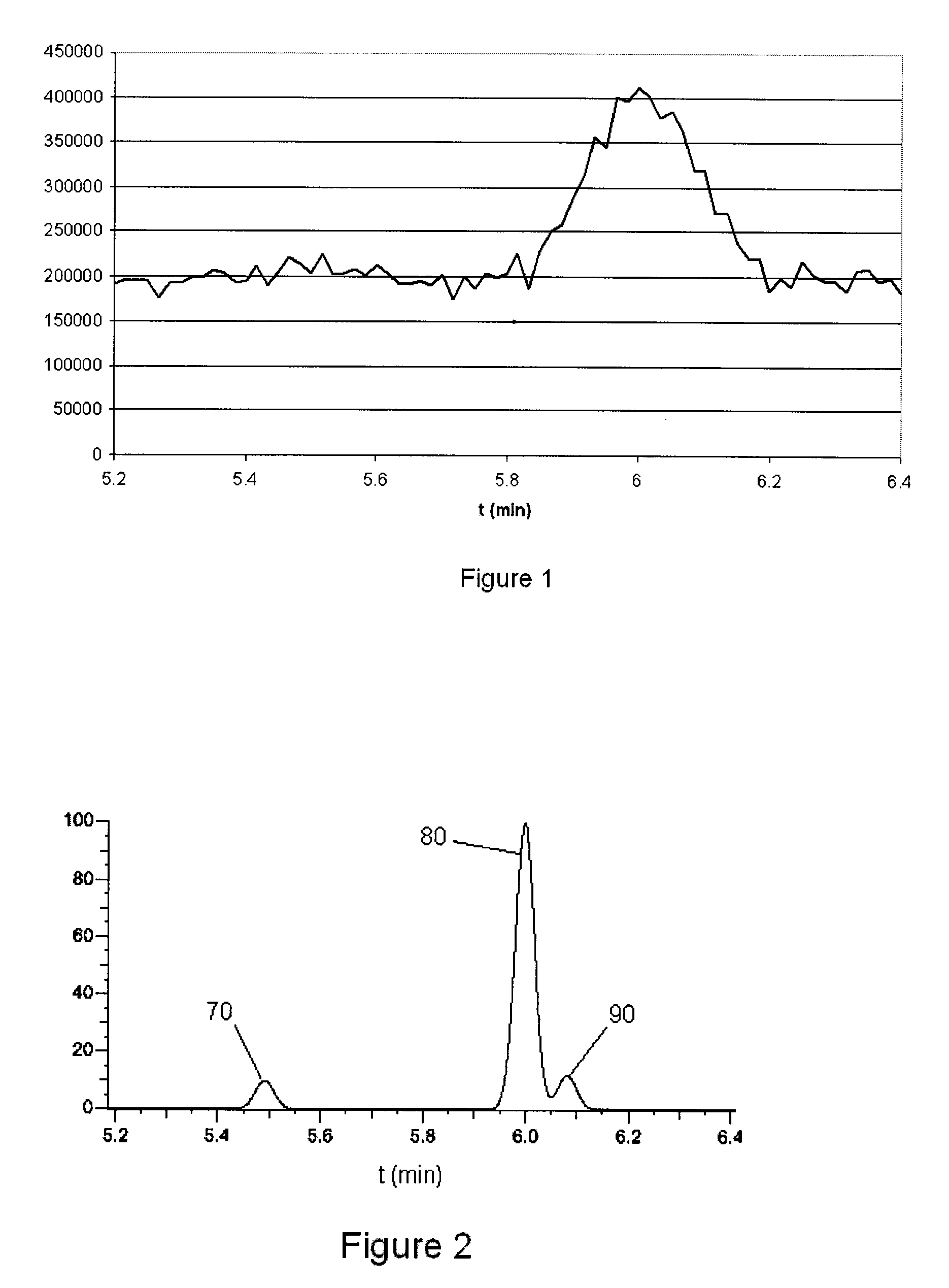[0110]A major
advantage of the invention is the suitability of the results for further use. The grouped peaks obtained in step (g) of the method of the present invention can be used for improved qualitative results like identification,
database search, determination of elemental compositions based on identified isotopic groups, identification of MS / MS fragments from multiplexed or non-isolated precursor ions, including in-source fragmentation, as well as for improvement of quantitative analysis, e.g. iTraq or SILAC methods, or detection of differences in metabolites or peptides (“expression”) between samples collected under different conditions.
[0111]In the present invention, outputting may be performed in any conventional manner, e.g. in
hard copy (e.g. paper), soft copy (e.g. VDU screen) or other form, and as any type of output, e.g. numerical form, table form, graphical or other form. It will be appreciated that any data sets or subsets, e.g. acquired, processed or generated, in the present invention may be stored, temporarily or permanently, using any conventional data storage medium and / or outputted.
[0112]The identified peaks determined to be due to an eluting compound having retention times within a given time period of one another are preferably combined into a single peak centred on a elution time which is a function of the elution times of the identified peaks. Preferably the said identified peaks are combined into a single peak by simply adding them together and the
resultant single peak has a peak maximum, width and
centroid according to the intensities of the identified peaks that formed it. The given time period is preferably a function related to the uncertainty of the measured spectroscopic quantities in the
time domain. Preferably the given time period is X times the standard deviation of the uncertainty of the measured spectroscopic quantities in the
time domain, where X is a value between 1 and 6. More preferably the given time period is 3 times the standard deviation of the uncertainty of the measured spectroscopic quantities in the
time domain.
[0113]The uncertainty of the measured spectroscopic quantities in the time domain is preferably determined on the basis of the difference in the measured elution times of spectroscopic species which should have the same elution time. In the case where the measured spectroscopic quantities are mass spectra, the uncertainty of the measured spectroscopic quantities in the time domain is preferably a function of the difference in the measured elution times of isotopes of the same molecular species.
[0114]The apparatus according to the present invention comprises a device for measuring spectroscopic quantities from an effluent eluted from the
chromatography device as a function of elution time, which is preferably a
spectrometer, e.g. a mass
spectrometer or an
optical spectrometer (e.g. UV, visible,
infrared, Raman etc.). Most preferably, i.e. for the most preferred embodiment measuring mass spectra, the device for measuring spectroscopic quantities is a mass spectrometer. The chromatography device is therefore most preferably interfaced to a mass spectrometer (e.g. LC / MS or GC / MS), i.e. such that at least some of the effluent from the chromatography device passes into the mass spectrometer for measurement of the spectroscopic quantities. The mass spectrometer may be any suitable type of mass spectrometer, e.g.
quadrupole,
ion trap, time-of flight (TOF), FT-ICR,
Orbitrap™ or any other commercially available type of mass spectrometer. An additional
detector, e.g. an
optical detector such as a PDA can be connected to the same chromatographic device and events can be identified in the same way and combined with the
mass spectrometric information. The device for measuring the spectroscopic quantities generates data representative of the measured spectroscopic quantities which is then processed in accordance with the invention. The generated data may be stored in any suitable data storage means for
processing.
[0115]The module for identifying at least some peaks in intensity as a function of time in the measured spectroscopic data is a type of
data processing module. The
data processing module may comprise, for example, a dedicated electronic device or a programmed computer. Typically, the
data processing module comprises a programmed computer. Similarly, the modules for discarding from the first set of identified peaks those peaks that are not due to an eluted compound thereby forming a second set of peaks from those retained; for transforming each peak in the second set of peaks into a first model peak centred on the elution time of each peak in the second set of peaks; for adding together some or all the model peaks created in step (d) to create a new chromatogram; for identifying at least some peaks in intensity in the new chromatogram; and for grouping together all identified peaks in intensity in the second set of peaks having elution times within a given time period of identified peaks in intensity in the new chromatogram and assigning them to a single eluted compound thereby forming a processed
data set, are types of data
processing module. The data
processing module may comprise, for example, a dedicated electronic device or a programmed computer. Typically, the data processing module comprises a programmed computer. Typically, the same programmed computer is used as the data processing module for all modules. The same programmed computer may additionally be the same computer which controls the device for measuring the spectroscopic data (e.g. mass spectrometer).
 Login to View More
Login to View More  Login to View More
Login to View More 


